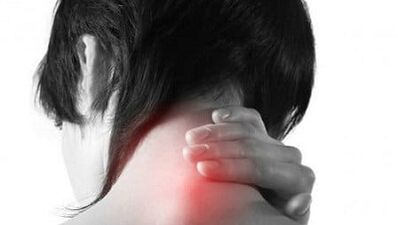
How to cure osteochondrosis in the cervical spine and what is the reason for its appearance?This problem is concerned about men and women who are forced to solve their health problems every day: from neck discomfort to severe headaches and other troubles.
The main reason for the development of the disease is to reduce the distance between the vertebrae due to the destruction of the cartilage between them.
For reference.Osteocartilage degeneration of the cervical vertebra is a degenerative disorder and is widely used due to excessive migration of the cervical vertebrae.The bone cartilage of the spine can cause uncontrolled physical activity, damage and muscle corsets.All of these causes ultimately lead to the development of cervical osteochondrosis.
Causes of the disease
The main reason for the development of cervical osteochondria is the reduction of the distance between the vertebrae due to the gradual destruction of the cartilage between them.Any failed position will cause the vertebrae to shift and blood vessels and nerves are pinched.
The most characteristic reasons for the development of osteochondrosis:
- Genetic susceptibility to disease.
- Too much weight and metabolic disorders.
- Frequent infection and body poisoning.
- Poor nutritional inadequateness, minimum intake of vitamins, trace elements and fluids lead to deformation of the vertebrae.
- Curvature of the spine, injury, bruising, fracture, violation of posture (osteochondrosis in the initial department).
- Flat feet and instability of the spinal segment, including in the cervical vertebra.
- Work related to weightlifting or frequent changes in body position (twitching, turns).
- A sedentary lifestyle, poor ecology.
- Hard work is carried out through the undeveloped bone muscle system, resulting in deformation of the vertebrae.
- Long-term forced body position, nerve overvoltage and pressure.
- The "wrong" sleep pillow changes the position of the vertebrae in the cervical vertebrae area.

A sedentary lifestyle increases the risk of illness.
It is important to remember that the beginning of osteochondrosis cannot be noticed.This is why there is any unpleasant feeling around the neck and it is necessary to contact the expert in time.
The following causes of osteochondrosis are theoretical, but found in practice:
Behavior
They are related to damage to tissue nutrients during the body’s aging, which is mainly suitable for intervertebral discs and vertebrae, and a large number of blood vessels pass through.
hormone
Along with hormone disease, changes in malnutrition (osteochondrosis) occur during the process, involving the disc.
Blood vessel
They were observed in violation of segmented circulation and water-salt metabolism.Subsequently, malnutritional changes develop in tissues and organs, including cervical osteochondrosis.
Infectiousness
Infections that occur in the discs of the cervical spine and the discs in the surrounding tissues destroy the spread of lymph fluid and lead to changes in tissue and cervical spine in nutrition.This is what causes the inherent spinal degeneration changes in osteochondrosis.
Bioelectricity
The reversal of the vector force of the bioelectric field in the intervertebral disc occurs due to injury, overload and temperature changes.Ultimately, osteochondrosis in the spine occurs, most commonly in multilayers.
Mechanical
Injury and significant loads of the spine lead to violations of the integrity of the annular fibrous and cervical disc dystrophy.
Heterogenous
This refers to the innate abnormalities in the spine and its various structural parts.Meanwhile, healthy vertebrae in the cervical area bears a double load, resulting in rapid wear and development of osteochondral osteochondral osteopathy in the neck.
Function
The main pathological changes are related to muscle tissue caused by congenital or familiar factors.Imbalance of contraction of muscles in a plane can cause osteochondrosis in the neck.
Disease stage
There are four diseases in cervical osteochondrosis.They are characterized by special symptoms and changes affecting the cervical region:

- On level 1Damage that violates the metabolic process can harm nuclear power.It becomes less elastic and dry and cannot cope with the load on the cervical spine.At level 1, the patient does not feel pain, only occasionally stiffness occurs.Treatment for damaging the cervical area at this stage is the most effective, and a simple massage lesson is helpful.
- At 2 degreesDamage to the annulus occurs, and microcracks form on the lateral and posterior surfaces of the vertebrae.Patients with pathology to this extent begin to experience neck pain.
- At 3 degreesThe bone structure changes, the fibrous annulus deforms and tear them.The patient feels the pain suffered by all nearby tissues, nerves and blood vessels, the patient's air lacks air, and the noise from the ears and head.Osteochondrosis with a 3-degree neck is characterized by pain in the back of the head, and it becomes very difficult to rotate the head.
- At 4 degreesThe degeneration of the spine is restored, and the process lasts for about a year.In deformed vertebrae, changes in bone tissue growth occur (increased in breadth).The morbid spine gradually turns into a static and painless frozen bone column.
Only by timely prevention of osteochondrosis can we help prevent the development of the disease.
The main manifestations of osteochondrosis (including Duozai) were discovered after the age of 35, and older, the more patients complained about the pain of the expert to the neck.The most common cause of pathology is to stay on computers and drive for a long time in our time.This forced position of the spine leads to stability in the spine.
Characteristics and clinical manifestations
The symptoms of cervical osteochondrosis have a distinct personality, which is different from those shown by other spinal diseases.This is due to the characteristics of the vertebrae structure and the fact that they are closer than the chest and waist parts.This is why even with the slightest pathology, the cervical cartilage becomes, making yourself feel faster.
The following signs of cervical osteocartilage degeneration are most characteristic:
pain
The first symptom makes a person understand the beginning of the problem.It can be positioned: neck, head, shoulders, and hand top.If the spine of the nerve is involved in the pathological process, which “responsible” the nerves in the upper part of the hand, there is an unpleasant feeling similar to weightlifting.Pain on the head and back occurs in severe cramps in the neck muscles.In addition, blood flow is disturbed, which can stimulate the appearance of symptoms of poor blood supply in the brain.
Weaknesses in your hands

Such symptoms are caused by damage to the nerve roots and fibers of motor function and dominate the muscles of the hand.
The symptoms of the disease may be weakness and poor sensitivity in the hands.
Poor sensitivity in hands
This symptoms are explained by damage to sensitive nerve fibers innervate the skin.
Limitations of crown and neck mobility
These are the characteristics of the disc "dry".In addition, bone tissue growth occurs and degeneration occurs in the small joints between the cervical spine.
Bad coordination
Symptoms indicate progress in cervical osteochondrosis.The nerves and vertebral arteries are squeezed, and when fibrous tissue is formed, blood flow worsens when vertebrae is displaced, resulting in symptoms, indicating insufficient blood supply to the cerebellum and brain.In severe cases, the following symptoms occur: hearing loss, speech numbness, and vision problems.
As you can see, osteochondrosis is by no means a harmless disease, it talks about eloquently and eloquently.
Principles of treatment measures
Treatment of cervical osteochondrosis in men and women is based on preventing all symptoms of the disease and eliminating the causes of cervical osteochondrosis development.Symptoms are mainly related to compression of nerve fibers and blood vessels, so eliminating edema, inflammation and restoring normal blood supply is the main one.When physical therapy exercises are involved, cervical osteochondrosis successfully retreats in the initial stages, while medications do not appeal to help.
The success of treatment depends only on the work of the team of qualified doctors.
As cervical osteochondrosis develops, local therapists are almost always targeting the primary therapists, which is of no help.Usually, its treatment is only symptomatic, but cannot completely detect and eliminate the cause of the disease.Therefore, the success of treatment depends only on the team of qualified doctors’ work: vertebrae doctors, neurologists, surgeons, physical therapists, and Masseur.

Treatment of osteochondrosis in the cervical area is important for the early stages of the beginning, otherwise, in stages 2-3, the vertebrae undergoes strong changes and treatment will be long, difficult and not always effective.Treatment for neck problems is based on medications, physical therapy, massage and therapeutic exercise.
Preparations for cervical bone cartilage:
- NSAID.
- Vitamin preparation.
- Drugs to improve blood flow.
- musorelaxant.
- Cartilage protector.
Treatment of cervical osteochondrosis using the following physical therapy:
- Ultrasound (relieves pain and improves metabolic processes).
- Electrophoresis (delivery drugs to the problem area).
- Laser therapy (relieves inflammation and improves blood circulation).
- Magnetic therapy (can relieve tissue edema).
Neck osteochondral disease should not be underestimated.In men and women, there is often a slight discomfort around the neck, especially when sitting on a computer or other forced position for a long time.In the beginning, you don’t need to take medication, but try to eliminate the cause or to recharge regularly (at work or at home).Indications for surgical treatment: Lack of conservative treatment effects (medicine, physical therapy, gymnastics), persistent pain, bone marrow disease, brain circulation disorders.






















